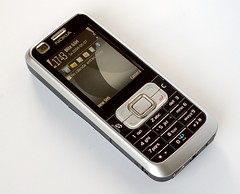
I got a new phone on Thursday, Nokia 6120 classic. It is my first Series 60 phone. I have been a loyal Nokia user for around four years now, mostly because of the ubiquity and universality of Nokia chargers. During the whole time they were producing GSM handsets, Nokia has changed the charger connector only two times. Each time the change was motivated by miniaturization.
Series 60 3rd edition is very nice. The UI metaphor is different from Series 40, but it's quite intuitive and comfortable. Surprisingly, there's no stopwatch app, but of course there already are too many Stopwatch apps for S60 on the web. Should I write another one? :-) There's a snag that this phone is not yet supported by Gnokii/Gammu/Wammu, so I had to install the Nokia PC suite on Windows in order to transfer my contacts from my old Nokia 6230i. Know what? It was not flawless. Getting the contacts from the 6230i was easy (if we ignore the constant Vista disk grinding), not so with restoring the backup on the 6120c. It took Nokia PC suite 3 attempts to create the Bluetooth pair, install the drivers on the PC and on the phone, and connect to the phone.
The phone has all the 3G technologies: UMTS, HSDPA. During my first Internet connection test on a late Thursday evening
speedtest.net indicated 1.2 Mbps down and about 100 kbps up with a 3.5G (HSDPA) connection. On a Saturday night though the speed fluctuated between 300-600 kbps on average, and it took a couple of attempts to establish an HSDPA connection, I would get EDGE instead. I'm using the Bitė GMS network. We'll see how things will go with Omnitel.
Yesterday I installed Python on the phone. I set up and played with a Bluetooth console. The Hardy bluez-utils are broken (see
Ubuntu bug 211525), so I had to install bluez-utils from Sid. The Bluetooth console is much more convenient than banging in Python code on the phone keyboard, but it does not have readline.
I got an impression that Nokia wants people to use Python on Series 60 very much. They try very hard to make it easy, provide all sorts of docs, even multimedia tutorials. Probably they see the ease and accessibility of Python as a path to widespread platform adoption. The Python API has easy access to most of the phone's functionality, including the GUI toolkit, camera, bluetooth, networking, messaging, contacts and so on. I have an impression that cooking a homebrew contacts backup/restore application in Python will be pretty trivial. I cannot start hacking away as Python looks for modules on the flash card, and I haven't bought a microSD card yet. On a positive note, it's nice that this time Nokia didn't include a cheap claustrophobic-sized card. They're useless after you buy a real card, but hard to throw away, so they contribute to cruft accumulation in life.
Unfortunately, Nokia only provides the platform SDK for Windows, but
there are ways to use the GNU toolchain in combination with the SDK and some Wine.
The SDK is needed in order to package Python scripts as SIS installable files. Even then, I'm not sure it will work, as Series 60 3rd ed. only accepts packages signed by a registered developer. There should to be a way to play with your own software, no idea yet what's involved.

